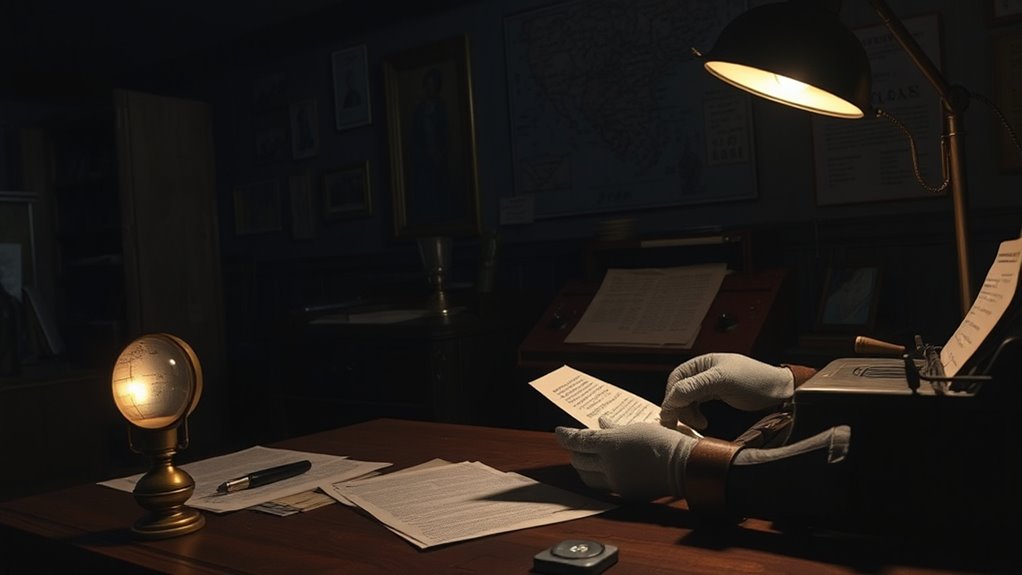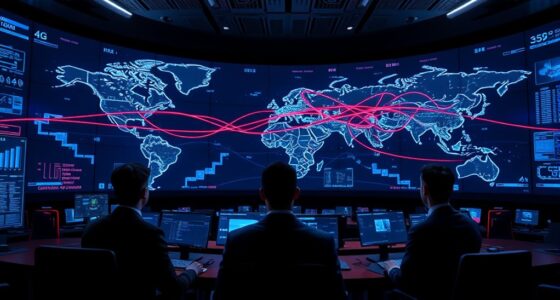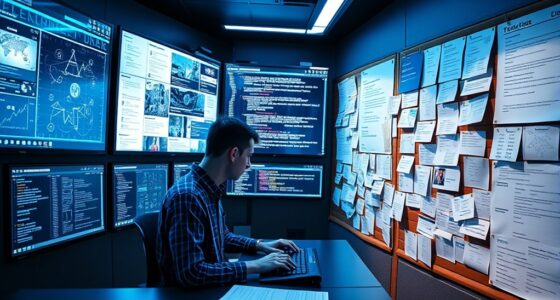Espionage has shaped history in mind-boggling ways. Did you know that codebreakers turned the tide of both World Wars? The Cold War saw the rise of double agents, influencing politics considerably. Notorious spies like Mata Hari showcased the power of psychological manipulation. Nowadays, cyberespionage targets crucial sectors, costing billions. Plus, modern intelligence faces ethical dilemmas regarding privacy and rights. If you’re curious about how these elements intertwine, there’s plenty more to uncover!
Key Takeaways
- The Berlin Tunnel, a Cold War operation, ingeniously infiltrated East Germany’s communication, showcasing the lengths spies would go to gather intelligence.
- Juan Pujol Garcia, a double agent in WWII, successfully misled the Nazis, earning the nickname “Garbo” for his deceptive prowess.
- Espionage tactics have evolved from traditional HUMINT methods to sophisticated cyberespionage, with China leading a 150% surge in cyber activities.
- Mata Hari, a famous spy during World War I, used psychological manipulation and seduction, highlighting the role of personal charm in espionage.
- Modern intelligence operations raise ethical concerns, balancing national security needs against individual rights and privacy in an age of advanced technology.
The Role of Codebreaking in Shaping History

As history shows, codebreaking has played a significant role in shaping the outcome of conflicts, particularly during the World Wars.
You’d be amazed at how the Allies’ capture of German codebooks in World War I provided essential intelligence that shifted the war’s momentum.
Fast forward to World War II, and the decryption of the Enigma machine at Bletchley Park allowed the Allies to anticipate enemy movements and counter U-boat attacks effectively.
The collaboration between British and American cryptographers under the “Ultra” alliance enhanced these efforts, yielding critical insights into Axis plans.
The “Ultra” alliance between British and American cryptographers was pivotal, providing vital intelligence on Axis strategies.
Ultimately, codebreaking was more than just a technical skill; it was a decisive factor that turned the tide in key battles, proving its historical significance.
Espionage During the Cold War: A Game of Shadows

Espionage thrived during the Cold War, as the United States and the Soviet Union engaged in a constant battle for supremacy. Key organizations like the CIA and KGB played crucial roles, infiltrating enemy ranks and intercepting essential communications.
They relied on double agents to gather military, government, and economic secrets, often leading to significant events such as McCarthyism. Notable operations, like the Berlin Tunnel, showcased both ingenuity and risk, while spy planes like the U-2 gathered intel over hostile territories.
Techniques like cryptography and electronic eavesdropping evolved, leaving a lasting impact on modern espionage. Ultimately, this shadowy game heightened paranoia and suspicion, shaping global politics in ways that still resonate today.
The Influence of Notorious Spies on Modern Techniques

While the tactics of notorious spies may seem like relics of the past, their influence on modern espionage techniques is undeniable. Figures like Juan Pujol Garcia and Mata Hari showcased the power of HUMINT, using deception and seduction to gather intelligence.
Today, these methods still thrive, with psychological manipulation and sexual espionage remaining essential in strategic operations. Innovations in surveillance, such as drones, reflect the evolution of techniques established by earlier spies like Sidney Reilly.
Counter-intelligence practices have also advanced, employing deep-cover agents to detect enemies. Even the use of gadgets, reminiscent of earlier espionage tools, plays a significant role in today’s intelligence landscape.
The legacy of these spies continues to shape how espionage unfolds in our modern world.
The Rise of Cyberespionage and Digital Footprints

The evolution of espionage has taken a significant turn in the digital age, where cyberespionage has emerged as a dominant threat. You mightn’t realize it, but cyber espionage targets confidential data, costing businesses and governments around $50 billion annually.
With a staggering 150% increase in China’s cyber activities, sophisticated tactics are now standard. Major sectors like finance, healthcare, and government agencies face relentless attacks, making you vulnerable to information breaches.
Advanced techniques like AI-driven social engineering and malware-free intrusions exploit your digital footprint. To safeguard yourself, utilize strong passwords, regularly update software, and invest in AI-driven security tools.
Continuous network monitoring can help you stay one step ahead of these covert operations.
Ethical Dilemmas in Modern Intelligence Operations

In traversing the complex landscape of modern intelligence operations, you’re likely to encounter a range of ethical dilemmas that challenge the balance between national security and individual rights.
For instance, when agencies collaborate with allies, they often face inconsistencies due to non-binding agreements, risking ethical variability. The use of human intelligence (HUMINT) methods raises moral questions, as deception and manipulation become necessary tools.
Furthermore, subcontracting intelligence tasks can lead to a lack of control over how information is gathered, further complicating accountability. As technologies evolve, concerns about data privacy and bias intensify.
Ultimately, you must navigate these ethical tensions while endeavoring to uphold both national interests and human rights.
Frequently Asked Questions
How Has Miniaturization Affected Modern Spy Tools?
Miniaturization has drastically transformed modern spy tools, making them more effective and versatile.
You can now hide devices in everyday objects, enhancing stealth during operations. Smaller gadgets reduce detection risks, allowing for discreet audio capture and advanced surveillance capabilities.
With the integration of AI and advanced sensors, you’re equipped to gather and analyze data more efficiently.
This evolution not only broadens your operational scope but also prepares you for future innovations in espionage technology.
What Role Does AI Play in Contemporary Espionage?
AI plays an essential role in contemporary espionage by enhancing data collection and analysis. You can leverage AI’s ability to process vast amounts of information, identifying patterns that humans might miss.
It accelerates decision-making and improves threat detection, making intelligence operations more efficient. With autonomous surveillance systems and AI-driven drones, you reduce human risk while increasing operational effectiveness.
However, ethical considerations and verification challenges require your attention as AI continues to evolve in this field.
Are There Ethical Standards for Commercial Spy Technology?
Yes, there are ethical standards for commercial spy technology. You need to guarantee that your operations comply with laws regarding data collection and respect individual privacy.
Transparency about how you use surveillance is vital, and you should establish accountability mechanisms.
It’s important to prevent discrimination, especially when using AI. Additionally, staying informed about regulatory differences and public awareness can help you navigate the ethical challenges in this rapidly evolving field.
What Is the Impact of Globalization on Espionage?
Globalization has considerably impacted espionage by increasing accessibility and expanding targets beyond government entities to private companies and individuals.
You’ll notice that technological advancements allow cyber espionage to occur from anywhere, making data theft more efficient.
As economies become intertwined, the implications of economic espionage grow, affecting multiple nations.
Additionally, legal challenges arise from the international nature of these activities, complicating enforcement and response efforts for all involved parties.
How Does Augmented Reality Enhance Intelligence Analysis?
Imagine stepping into a world where reality intertwines with digital wonders. Augmented reality enhances intelligence analysis by immersing you in real-time data, helping you visualize complex scenarios like a master artist painting a vivid landscape.
It tracks objects seamlessly, labels them instantly, and even translates languages on the fly. With predictive insights and interactive visualizations, your decision-making becomes sharper, turning raw data into a powerful narrative that drives effective intelligence operations.
Conclusion
As you explore the world of espionage, remember it’s like a high-stakes game of chess, where one wrong move can change the course of history. Just like how Alan Turing’s codebreaking efforts during World War II not only saved countless lives but also paved the way for modern computing, every secret uncovered today could reshape our future. Embrace the intrigue, but also consider the ethical shadows that linger in the pursuit of knowledge and security.









